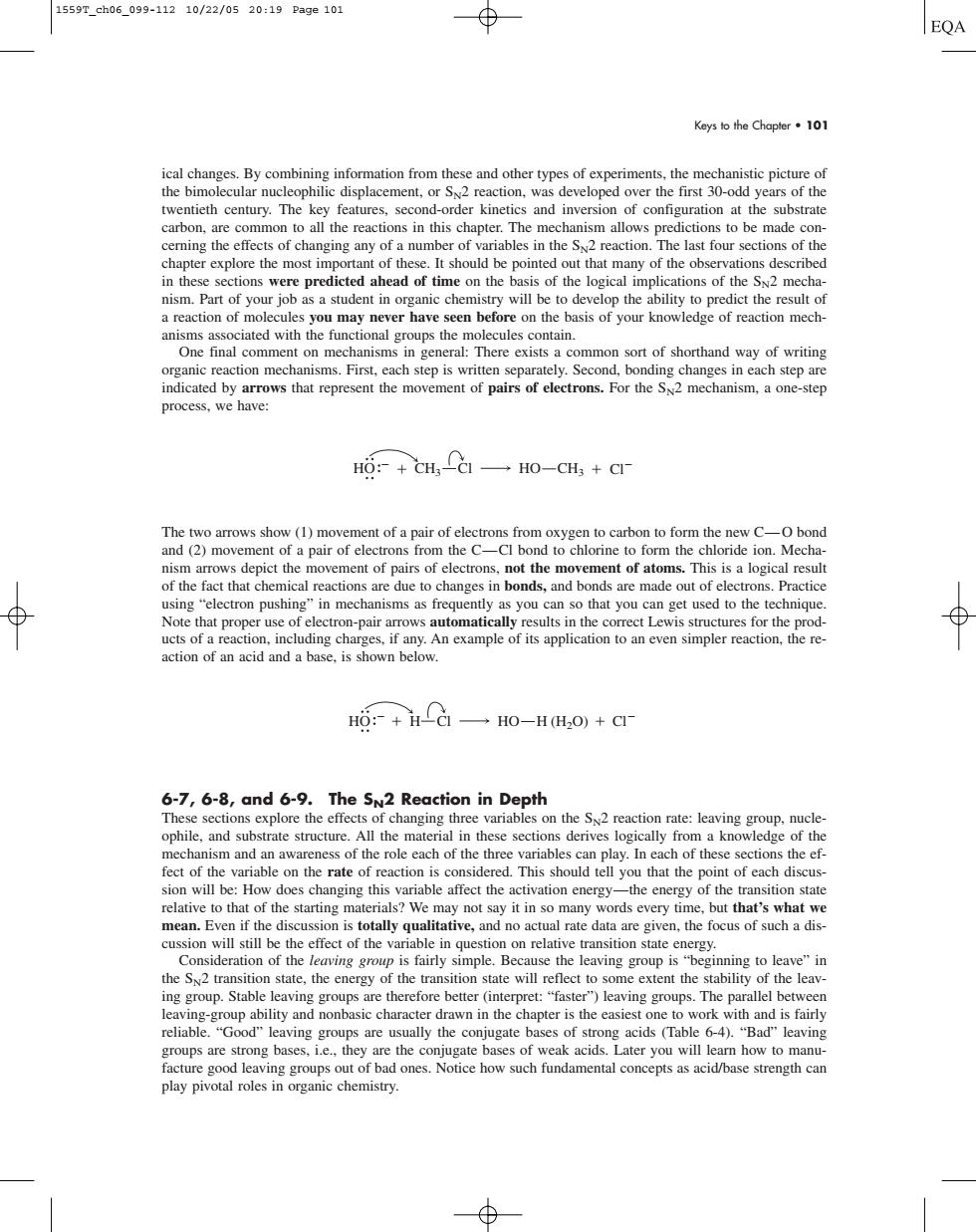正在加载图片...

1559T_ch06_099-11210/22/0520:19Pa9e101 ⊕ EQA Keys to the Chopler·101 twenticth century.The key features,second-order kinetics and inversion of configuration at the substrate ns in hapter.Then the a to be made apter explore the most important of these.It should be pointed out that many of the observ tions s were predic ahead of time on the of the logica 2 mech a reaction of molecules you may never have seen before on the basis of your knowledge of reaction mech- anis of shor indicated by arrows that represent the movement of pairs of electrons.For the 2 mechanism.a one-step process,we have: H:+aH,一H0-CH+a on.bond nism arrows depict the movement of pairs of electrons.not the m rement of atoms.This is a logical result of the fact that chemical reactions are due to changes in bonds,and bonds are made out of electrons.Practice action of an acid and a base,is shown below 0:+ia6一o-HH,o+a 6-7,6-8,and 6-9.The SN2 Reaction in Depth These sections explore the effects of changing three variables on the S2 reaction rate:leaving group.uce ophile,and substrate structure.A a knowledge of the fect of the variable on the rate of reaction is considered.This should tell you that the point of cach discus sion will be:Hov does changing this variable affect the activation energy- the energy of the transition state may not say It in s ny words every t .the out th nat's what w eration of Be e the. to leave”i inggroup.Stable leaving groupsare therefore better (interpret:faste)leaving groups.The parallel betwe pter is the easies oups are strone they are the co aving groups out of bad ones.Notice how such fundamental concepts as acid/base strength can play pivotal roles in organic chemistry Keys to the Chapter • 101 ical changes. By combining information from these and other types of experiments, the mechanistic picture of the bimolecular nucleophilic displacement, or SN2 reaction, was developed over the first 30-odd years of the twentieth century. The key features, second-order kinetics and inversion of configuration at the substrate carbon, are common to all the reactions in this chapter. The mechanism allows predictions to be made concerning the effects of changing any of a number of variables in the SN2 reaction. The last four sections of the chapter explore the most important of these. It should be pointed out that many of the observations described in these sections were predicted ahead of time on the basis of the logical implications of the SN2 mechanism. Part of your job as a student in organic chemistry will be to develop the ability to predict the result of a reaction of molecules you may never have seen before on the basis of your knowledge of reaction mechanisms associated with the functional groups the molecules contain. One final comment on mechanisms in general: There exists a common sort of shorthand way of writing organic reaction mechanisms. First, each step is written separately. Second, bonding changes in each step are indicated by arrows that represent the movement of pairs of electrons. For the SN2 mechanism, a one-step process, we have: The two arrows show (1) movement of a pair of electrons from oxygen to carbon to form the new C— O bond and (2) movement of a pair of electrons from the C—Cl bond to chlorine to form the chloride ion. Mechanism arrows depict the movement of pairs of electrons, not the movement of atoms. This is a logical result of the fact that chemical reactions are due to changes in bonds, and bonds are made out of electrons. Practice using “electron pushing” in mechanisms as frequently as you can so that you can get used to the technique. Note that proper use of electron-pair arrows automatically results in the correct Lewis structures for the products of a reaction, including charges, if any. An example of its application to an even simpler reaction, the reaction of an acid and a base, is shown below. 6-7, 6-8, and 6-9. The SN2 Reaction in Depth These sections explore the effects of changing three variables on the SN2 reaction rate: leaving group, nucleophile, and substrate structure. All the material in these sections derives logically from a knowledge of the mechanism and an awareness of the role each of the three variables can play. In each of these sections the effect of the variable on the rate of reaction is considered. This should tell you that the point of each discussion will be: How does changing this variable affect the activation energy—the energy of the transition state relative to that of the starting materials? We may not say it in so many words every time, but that’s what we mean. Even if the discussion is totally qualitative, and no actual rate data are given, the focus of such a discussion will still be the effect of the variable in question on relative transition state energy. Consideration of the leaving group is fairly simple. Because the leaving group is “beginning to leave” in the SN2 transition state, the energy of the transition state will reflect to some extent the stability of the leaving group. Stable leaving groups are therefore better (interpret: “faster”) leaving groups. The parallel between leaving-group ability and nonbasic character drawn in the chapter is the easiest one to work with and is fairly reliable. “Good” leaving groups are usually the conjugate bases of strong acids (Table 6-4). “Bad” leaving groups are strong bases, i.e., they are the conjugate bases of weak acids. Later you will learn how to manufacture good leaving groups out of bad ones. Notice how such fundamental concepts as acid/base strength can play pivotal roles in organic chemistry. Cl HO H Cl HO H (H2O) Cl HO CH3 Cl HO CH3 1559T_ch06_099-112 10/22/05 20:19 Page 101��������